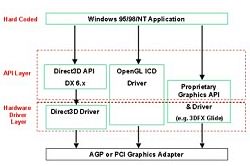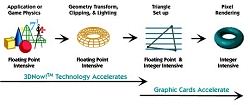| AMD and 3dNOW
from AMD's White Paper |
||||
|
The benefits of 3DNow! technology must be realized through software modifications. To understand these benefits, it is helpful to look at the software architecture.
 Potential 3DNOW Optimizations First, 3DNow! technology is operating system independent; that is, no modifications are required within Windows 9x or Windows NT to support this technology. Second, floating point operations are used throughout the various layers of software. There are three basic areas for software optimization involving 3DNow! technology that will yield performance improvements: Native 3DNow! optimization within an application or game Optimizations within an API, such as DirectX 6.x or OpenGL, in which the application calls the API to perform the floating-point-intensive 3D geometry routines Graphic driver level optimizations. Each of these methods alone yields performance improvements. Optimizing all three components will yield the maximum improvement possible. AMD and our ISV/IHV partners will have optimized two common layers of software-the API software layer (DirectX and OpenGL), as well as the graphic card driver layer. A natively optimized software title is one in which an ISV has hand-coded or used AMD's SDK tools to optimize their code. Native optimization can be done either as part of the initial ground-up design of a new application, or it can be done near the completion of an application. |
 3d Pipeline Although most performance optimization usually occurs near the end of development, it is important to consider the code structure as early as possible in the development process. Early adoption is encouraged because it enables new features and data structures that will lead to optimal performance. AMD offers programming tools that assist developers in the optimization process. These tools allow developers to replace inefficient floating point (x87) instructions with SIMD-style instructions that support multiple instructions per clock cycle. Converting x87 instructions to 3DNow! instructions involves two 32-bit single precision floating point values grouped into a single 64-bit vector. Two vector computations can run through the dual fully pipelined register units within the AMD-K6-2 or AMD-K6-III processor. This allows for potential peak performance of four 32-bit single precision floating point values being processed in one clock cycle, or a 4:1 processing advantage over standard x87 code implementation used in Pentium® II. For example, a 500-MHz AMD processor with 3DNow! technology has a potential peak rating of 2.0 Gigaflops (single precision), while a competing processor using standard x87 instructions would be rated at 500 Megaflops (0.5 Gigaflops). This significant increase in processing power will bring 3D into mainstream personal computing as ISVs begin to design applications with 2.0 Gigaflops of performance in mind. Need more information? Go to AMD 3dNOW
|
|||
|
Copyright © 1997 - 2000 COMBATSIM.COM, INC. All Rights Reserved. Last Updated June 29th, 1999 |
||||
